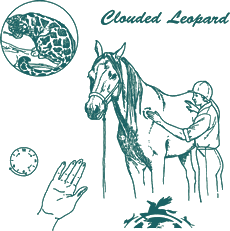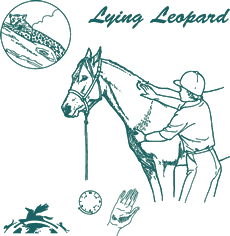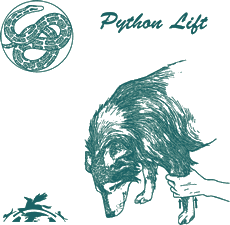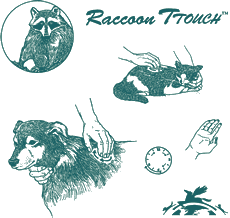Examples of TTouches
The Clouded Leopard
 The basic Tellington TTouch is the Clouded Leopard, named after a Clouded Leopard in the Los Angeles Zoo. The "cloud" part of the name describes the lightness with which the whole hand contacts the body, and the "leopard" stands for the range of pressure of the fingers. A leopard can be very light on his feet as in the light TTouch of a one, two, or three, or very strong, as in the eight to ten pressure scale. The stronger Leopard TTouch is appropriate for the more heavily muscled or blocked animal. This TTouch is used all over the body with the intention of increasing awareness and confidence.
The basic Tellington TTouch is the Clouded Leopard, named after a Clouded Leopard in the Los Angeles Zoo. The "cloud" part of the name describes the lightness with which the whole hand contacts the body, and the "leopard" stands for the range of pressure of the fingers. A leopard can be very light on his feet as in the light TTouch of a one, two, or three, or very strong, as in the eight to ten pressure scale. The stronger Leopard TTouch is appropriate for the more heavily muscled or blocked animal. This TTouch is used all over the body with the intention of increasing awareness and confidence.
How to: The weight of the hand rests lightly on the body with fingers lightly curved like a leopard's paw. The pads of your fingers push the skin in one and a quarter circles. The middle finger leads. Fell the connection between your forefinger and thumb, which are held several inches apart. Keep your wrist soft. Breathing in rhythm with the circles helps maintain a softness in fingers, hand, arm and shoulder. Move the skin in a circle rather than rubbing over the hair. Watch your horse's reaction. If he or she seems uncomfortable, lighten the pressure of change the TTouch.
Uses and Pressure for The Clouded Leopard:
- Back Problems 2–4
- Building Self-Confidence 4–6
- Increased Circulation 4–6
- Lameness 3–6
- Reducing Stress 3–5
- Reducing Tension 3–5
- Sensitive Areas 3–5
- Sore Muscles 2–4
- Stiffness 2–5
The Lying Leopard
 This is a variation of the Clouded Leopard. If a horse appears to be too sensitive to the Clouded Leopard, it is less invasive to use the Lying Leopard. It is good for reducing pain and the possibility of swelling from injury. When an area is sore or sensitive, lightly cup your hand over the wounded area and move the area in a small circle, keeping the raised cupped portion of your hand directly over the injury.
This is a variation of the Clouded Leopard. If a horse appears to be too sensitive to the Clouded Leopard, it is less invasive to use the Lying Leopard. It is good for reducing pain and the possibility of swelling from injury. When an area is sore or sensitive, lightly cup your hand over the wounded area and move the area in a small circle, keeping the raised cupped portion of your hand directly over the injury.
How to: For this TTouch the leopard lies down, i.e., the curve of the hand flattens somewhat, allowing a larger area of warm contact. The extended fingers and palm maintain a softness in the hand, arm, and shoulder that will help you to keep your breathing quiet and rhythmic.
If the animal is nervous or doesn't want to be touched, make the circles slightly faster, and then slow down as she/he relaxes. As you slow down, become aware of making the circle round and clearly moving the skin under your fingers.
Compare the feeling of the Lying Leopard and the Clouded Leopard on your own arm by making circles in several places. First use one touch and then the other. This will help you see and feel the difference and to know when to use each of them. Test the touches on a human friend to get feedback; see if he or she can tell the difference when you hold your breath and when you breathe with the movement of the circle.
The Lying Leopard TTouch is one that I often use for fresh injuries to reduce the pain and the possibility of swelling. When an area is really painful or injured, very lightly cup your hand over the wounded area and move the whole area in a circle, keeping the raised, cupped portion of your hand directly over the injury.
Do this to yourself and note the sensation: it should impart a protective feeling. If the area is too painful to approach immediately, make gentle, slow Lying Leopard circles all around the injury first, before cupping your hand over it. If the wound is open and you have first-aid equipment available, place a sterile covering over the wound before approaching it.
Uses and Pressure for the Lying Leopard:
- Bruising/Swelling 1–3
- Cinchiness 3–5
- Injuries 1–3
- Nervousness 2–4
- Reducing Stress 2–4
- Reducing Tension 3–
- Relaxation 2–4
- Shyness 3–5
The Python Lift
 The Python Lift is named after Joyce, a gentle 11 foot-long Burmese Python suffering from a recurring respiratory problem, upon whom I worked at the San Diego Zoo.
The Python Lift is named after Joyce, a gentle 11 foot-long Burmese Python suffering from a recurring respiratory problem, upon whom I worked at the San Diego Zoo.
The Python Lift is used to relieve and release tension and spasm. It is effective on the shoulder, legs, neck and back of animals, and also feels great on human backs, arms, legs and shoulders. The Python Lift relaxes nervous animals and improves balance and gait. It also helps to bring your animal into a state of mental and emotional stability.
How to: The whole hand is placed on the body or around the leg with just enough pressure to gently lift the skin and muscle. Lift, pause for several seconds, and then slowly return the skin to the starting point. Remember to breathe with the movement. If you lift too much it causes the animal to tense or move away.
The Raccoon TTouch
 This TTouch is named after the tiny, delicate movements of a raccoon washing its food.
This TTouch is named after the tiny, delicate movements of a raccoon washing its food.
Special uses: for small animals and delicate work; for working the area around wounds; to speed up healing; and to increase circulation and activate neural impulses in the lower legs. This TTouch is also used to reduce swelling without causing pain.
How to: Contact with the lightest possible pressure, using the tips of the fingers just behind the nails.

